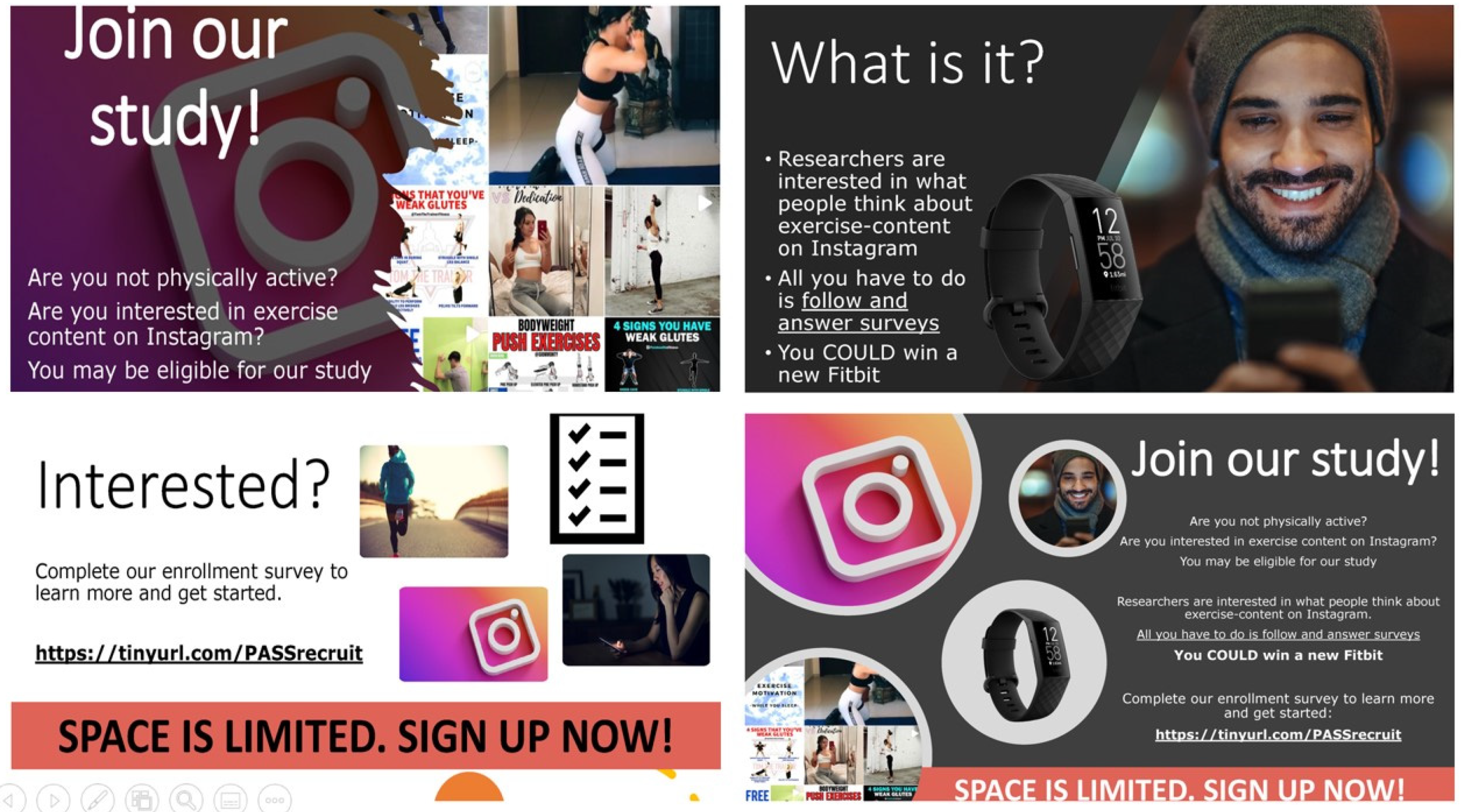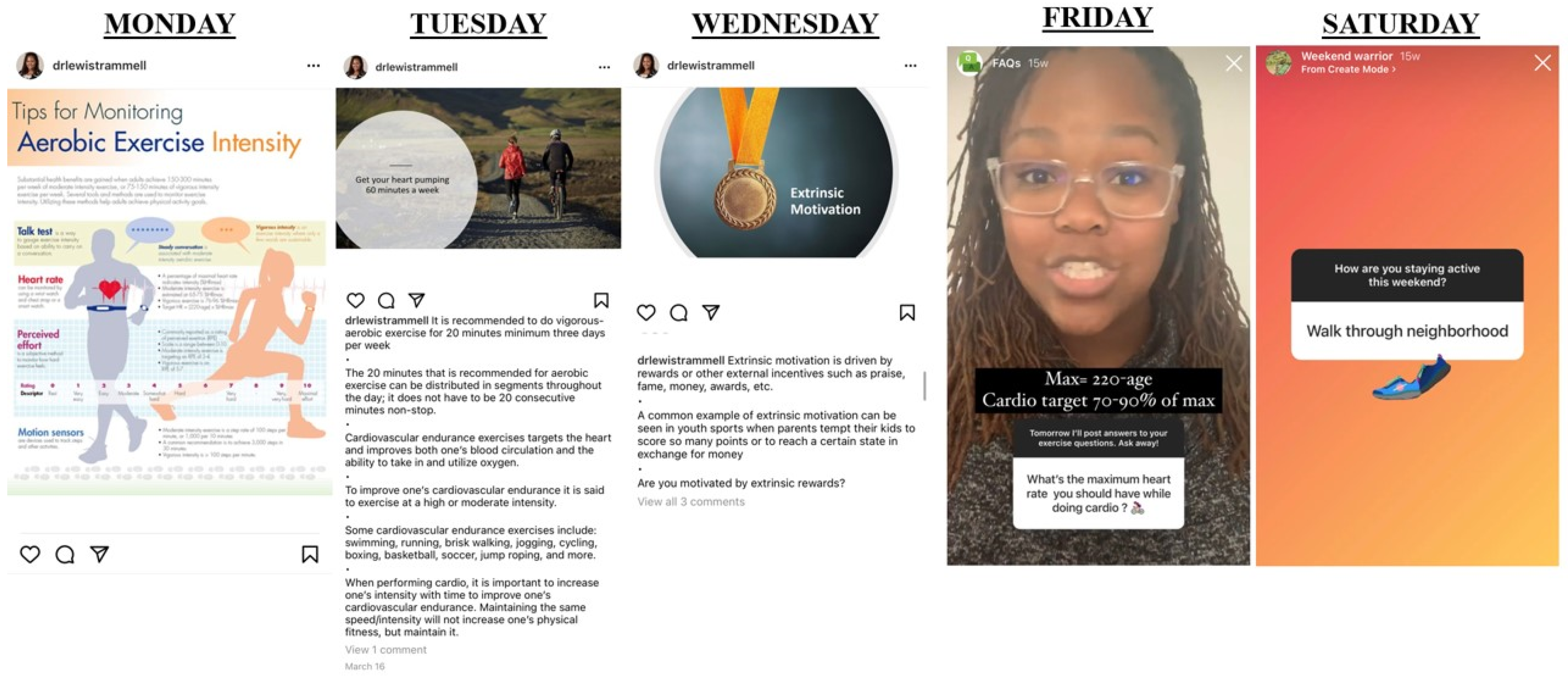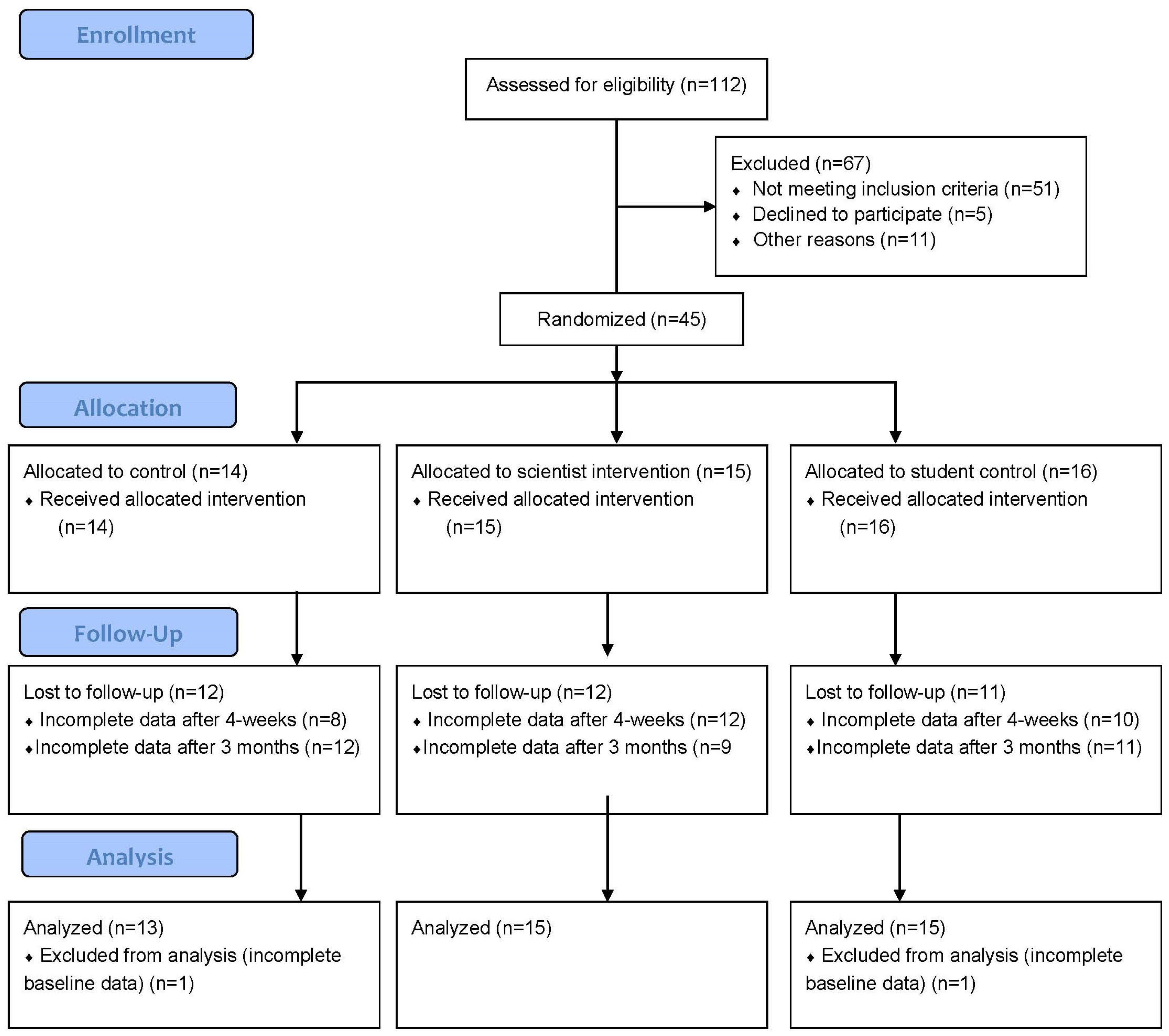The Protocol and Feasibility Results of a Preliminary Instagram-Based Physical Activity Promotion Study
Abstract
:1. Introduction
2. Methods
2.1. Formative Research
2.2. Protocol
2.3. Intervention
2.4. Study Measures
2.5. Statistical Analyses
3. Results
3.1. Reach
3.2. Feasibility
3.3. Acceptability
4. Discussion
4.1. Study Findings
4.2. Social Media Feasibility
4.3. Lessons Learned and Future Directions
4.4. Limitations and Strengths
5. Conclusions
Supplementary Materials
Author Contributions
Funding
Institutional Review Board Statement
Informed Consent Statement
Data Availability Statement
Acknowledgments
Conflicts of Interest
References
- King, A.C.; Whitt-Glover, M.C.; Marquez, D.X.; Buman, M.; Napolitano, M.A.; Jakicic, J.; Fulton, J.E.; Tennant, B.L. Physical Activity Promotion: Highlights from the 2018 Physical Activity Guidelines Advisory Committee Systematic Review. Med. Sci. Sports Exerc. 2019, 51, 1340–1353. [Google Scholar] [CrossRef] [PubMed]
- Maher, C.A.; Lewis, L.K.; Ferrar, K.; Marshall, S.; De Bourdeaudhuij, I.; Vandelanotte, C. Are Health Behavior Change Interventions That Use Online Social Networks Effective? A Systematic Review. J. Med. Internet Res. 2014, 16, e40. [Google Scholar] [CrossRef] [PubMed] [Green Version]
- Maher, C.; Ryan, J.; Ambrosi, C.; Edney, S. Users’ experiences of wearable activity trackers: A cross-sectional study. BMC Public Health 2017, 17, 1–8. [Google Scholar] [CrossRef] [Green Version]
- Ferrer, D.A.; Ellis, R. A Review of Physical Activity Interventions Delivered via Facebook. J. Phys. Act. Health 2017, 14, 823–833. [Google Scholar] [CrossRef] [PubMed]
- Edney, S.; Bogomolova, S.; Ryan, J.; Olds, T.; Sanders, I.; Maher, C. Creating Engaging Health Promotion Campaigns on Social Media: Observations and Lessons from Fitbit and Garmin. J. Med. Internet Res. 2018, 20, 11. [Google Scholar] [CrossRef] [PubMed] [Green Version]
- DiBisceglie, S.; Arigo, D. Perceptions of# fitspiration activity on Instagram: Patterns of use, response, and preferences among fitstagrammers and followers. J. Health Psychol. 2019, 26, 1233–1242. [Google Scholar] [PubMed]
- Al-Eisa, E.; Al-Rushud, A.; Alghadir, A.; Anwer, S.; Al-Harbi, B.; Al-Sughaier, N.; Al-Yoseef, N.; Al-Otaibi, R.; Al-Muhaysin, H.A. Effect of Motivation by “Instagram” on Adherence to Physical Activity among Female College Students. BioMed Res. Int. 2016, 2016, 1–6. [Google Scholar] [CrossRef] [PubMed] [Green Version]
- Schulz, K.F.; Altman, D.G.; Moher, D. WITHDRAWN: CONSORT 2010 statement: Updated guidelines for reporting parallel group randomised trials. Int. J. Surg. 2010. Withdrawn Article in Press. [Google Scholar] [CrossRef]
- Warburton, D.E.R.; Jamnik, V.; Bredin, S.S.D.; Gledhill, N. The 2014 Physical Activity Readiness Questionnaire for Everyone (PAR-Q+) and electronic Physical Activity Readiness Medical Examination (ePARmed-X+). Health Fit. J. Can. 2014, 7, 80–83. [Google Scholar]
- Warburton, D.E.R.; Jamnik, V.; Bredin, S.S.D.; Gledhill, N. The Physical Activity Readiness Questionnaire for Everyone (PAR-Q+) and Electronic Physical Activity Readiness Medical Examination (ePARmed-X+). Health Fit. J. Can. 2011, 4, 3–23. [Google Scholar]
- Pocock, S.J. Clinical Trials: A Practical Approach; John Wiley & Sons: Hoboken, NJ, USA, 2013. [Google Scholar]
- Create a Blocked Randomisation List. 2020. Available online: https://www.sealedenvelope.com/simple-randomiser/v1/lists (accessed on 27 January 2021).
- Lee, P.H.; Macfarlane, D.J.; Lam, T.; Stewart, S.M. Validity of the international physical activity questionnaire short form (IPAQ-SF): A systematic review. Int. J. Behav. Nutr. Phys. Act. 2011, 8, 115. [Google Scholar] [CrossRef] [Green Version]
- Edhlund, B.; McDougall, A. NVivo 12 Essentials; Lulu. Com: Morrisville, NC, USA, 2019. [Google Scholar]
- Chou, W.-Y.S.; Oh, A.; Klein, W.M.P. Addressing Health-Related Misinformation on Social Media. JAMA 2018, 320, 2417–2418. [Google Scholar] [CrossRef]
- Sterne, J.A.C.; Savović, J.; Page, M.; Elbers, R.G.; Blencowe, N.; Boutron, I.; Cates, C.; Cheng, H.-Y.; Corbett, M.S.; Eldridge, S.M.; et al. RoB 2: A revised tool for assessing risk of bias in randomised trials. BMJ 2019, 366, l4898. [Google Scholar] [CrossRef] [PubMed] [Green Version]
- Pope, Z.C.; Barr-Anderson, D.J.; Lewis, B.A.; Pereira, M.A.; Gao, Z. Use of Wearable Technology and Social Media to Improve Physical Activity and Dietary Behaviors among College Students: A 12-Week Randomized Pilot Study. Int. J. Environ. Res. Public Health 2019, 16, 3579. [Google Scholar] [CrossRef] [PubMed] [Green Version]
- Rose, T.; Barker, M.; Jacob, C.M.; Morrison, L.; Lawrence, W.; Strömmer, S.; Vogel, C.; Woods-Townsend, K.; Farrell, D.; Inskip, H.; et al. A Systematic Review of Digital Interventions for Improving the Diet and Physical Activity Behaviors of Adolescents. J. Adolesc. Health 2017, 61, 669–677. [Google Scholar] [CrossRef] [PubMed] [Green Version]



| Monday | Tuesday | Wednesday | Thursday | Friday | Saturday/Sunday | |
|---|---|---|---|---|---|---|
| Daily content schedule | Exercise infographic: Provide physical activity related data | Exercise tip and/or instructional video: Provide education on the principles of exercise science and/or provide an instructional video on how to perform an exercise | Motivation: Provide a motivation statement or education on exercise motivation | Ask the admin a question: Through the stories feature, participants submitted an exercise-related question to the admin | FAQ answers: The admin uploaded a video answering questions they received the previous day | Weekend warriors: Through the story feature participants were encouraged to share their weekend exercise plans |
| Weekly topic | Week 1: Physical activity and health | |||||
| Week 2: Physical activity guidelines | ||||||
| Week 3: Aerobic exercise | ||||||
| Week 4: Walking | ||||||
| Week 5: Strength training | ||||||
| Week 6: Recovery | ||||||
| Week 7: Exercise | ||||||
| Week 8: Overload | ||||||
| Week 9: Specificity | ||||||
| Week 10: Progression | ||||||
| Week 11: Adaption | ||||||
| Week 12: Reversibility | ||||||
| Week 13: Individual differences | ||||||
| Scientist Group (n = 15) | Student Group (n = 16) | Control Group (n = 14) | Total (n = 45) | |
|---|---|---|---|---|
| % | ||||
| Age | ||||
| 18–25 years | 33.3 | 44.4 | 53.8 | 46.5 |
| 26–39 years | 40.0 | 33.3 | 38.5 | 39.5 |
| 40–59 years | 26.7 | 5.6 | 7.7 | 14.0 |
| Gender | ||||
| Male | 46.7 | 14.3 | 7.7 | 23.8 |
| Female | 46.7 | 86.7 | 9.3 | 73.8 |
| Non-binary | 6.7 | - | - | 2.4 |
| Race | ||||
| White | 46.7 | 64.3 | 30.8 | 47.6 |
| African American/Black | 16.6 | 14.3 | 23.1 | 16.7 |
| Asian | 20.0 | 14.3 | 23.1 | 23.8 |
| Other | 6.7 | 7.1 | 23.1 | 11.9 |
| Where do you reside? | ||||
| CA | 40.0 | 35.7 | 61.5 | 45.2 |
| Other | 60.0 | 64.3 | 38.5 | 54.8 |
| Level of education | ||||
| High school graduate | - | 20.0 | - | 7.0 |
| Some college | 20.0 | 40.0 | 53.8 | 37.2 |
| 2-year degree | 13.3 | 6.7 | 7.7 | 9.3 |
| 4-year degree | 40.0 | 6.7 | 23.1 | 23.3 |
| Professional degree | 26.7 | 26.7 | 15.4 | 23.3 |
| Time using Instagram | ||||
| 6–12 months | 6.7 | - | - | 2.3 |
| 1–2 years | - | - | 7.7 | 2.3 |
| >2 years | 93.3 | 100.0 | 92.3 | 95.3 |
| Frequency using Instagram | ||||
| 1–3 times per month | 6.7 | - | 7.7 | 4.7 |
| 1–6 times per week | 6.7 | 6.7 | 7.7 | 7.0 |
| 1–2 times per day | 6.7 | 13.3 | 15.4 | 11.6 |
| 3–6 times per day | 20.0 | 40.0 | 38.5 | 32.6 |
| 7+ times per day | 60.0 | 40.0 | 30.8 | 44.2 |
| Physical activity category | ||||
| High | 53.3 | 60.0 | 57.1 | 56.8 |
| Moderate | 26.7 | 6.7 | 35.7 | 22.7 |
| Low | 20.0 | 33.3 | 7.1 | 20.5 |
| Scientist Group (n = 15) | Student Group (n = 15) | Control Group (n = 13) | |
|---|---|---|---|
| Did you learn something new about physical activity from the Instagram account? (%) | |||
| Strongly disagree | 6.7 | - | 30.7 |
| Somewhat disagree | 20.0 | 6.7 | 23.1 |
| Neither agree nor disagree | 20.0 | 33.3 | 23.1 |
| Somewhat agree | 26.7 | 40.0 | 23.1 |
| Strongly agree | 26.7 * | 20.0 * | - |
| On a scale of 1–10, how much do you enjoy the Instagram account? (mean, SD) | 5.9 (3.2) | 6.8 (2.6) * | 2.9 (2.6) |
| Overall, how satisfied are you with the account? (%) | |||
| Extremely dissatisfied | - | - | 30.0 |
| Somewhat dissatisfied | 11.1 | 9.1 | 30.0 |
| Neither satisfied nor dissatisfied | 33.3 | 18.2 | 20.0 |
| Somewhat satisfied | 44.4 | 54.5 | 20.0 |
| Extremely satisfied | 11.1 * | 18.2 * | - |
| Physical activity category (%) | |||
| High | 66.7 | 73.3 | 42.9 |
| Moderate | 6.6 | 6.7 | 35.7 |
| Low | 26.7 | 20.0 | 21.4 |
Publisher’s Note: MDPI stays neutral with regard to jurisdictional claims in published maps and institutional affiliations. |
© 2021 by the authors. Licensee MDPI, Basel, Switzerland. This article is an open access article distributed under the terms and conditions of the Creative Commons Attribution (CC BY) license (https://creativecommons.org/licenses/by/4.0/).
Share and Cite
Lewis, Z.H.; Danayan, S. The Protocol and Feasibility Results of a Preliminary Instagram-Based Physical Activity Promotion Study. Technologies 2021, 9, 70. https://doi.org/10.3390/technologies9040070
Lewis ZH, Danayan S. The Protocol and Feasibility Results of a Preliminary Instagram-Based Physical Activity Promotion Study. Technologies. 2021; 9(4):70. https://doi.org/10.3390/technologies9040070
Chicago/Turabian StyleLewis, Zakkoyya H., and Shalis Danayan. 2021. "The Protocol and Feasibility Results of a Preliminary Instagram-Based Physical Activity Promotion Study" Technologies 9, no. 4: 70. https://doi.org/10.3390/technologies9040070
APA StyleLewis, Z. H., & Danayan, S. (2021). The Protocol and Feasibility Results of a Preliminary Instagram-Based Physical Activity Promotion Study. Technologies, 9(4), 70. https://doi.org/10.3390/technologies9040070







